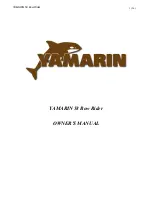
Section B
Page 5
Horizon & Sundowner
Owners Manual
06/00
2. Its weight is about the same as air so it cannot be
expected to rise or fall like some other gases, but
will distribute itself throughout the space.
NOTICE
DO NOT rely on the use of smell or sight of
other gases to detect CO, because it diffuses in
the air much more rapidly than easily detectable
(visible and odorous) gases.
B. What Makes Carbon Monoxide
Any time a material containing carbon burns such as
gasoline, natural gas, oil, propane, coal, or wood, CO is
produced.
Common sources of carbon monoxide are:
1. Internal combustion engines.
2. Open flame devices such as:
a. Cooking ranges
b. Central heating plants
c. Space heaters
d. Water heaters
e. Fireplaces
f. Charcoal grills
C. How a Person is Affected by Carbon
Monoxide
Carbon monoxide is absorbed by the lungs and reacts
with blood hemoglobin to form carboxyhemoglobin, which
reduces the oxygen carrying capacity of the blood. The
result is a lack of oxygen for the tissues with the subse-
quent tissue death and,
if prolonged, death of the in-
dividual.
D. Effects of Carbon Monoxide
Carbon monoxide in high concentrations can be fatal in
a matter of minutes. Lower concentrations must not be
ignored because the effects of exposure to CO are cu-
mulative and can be just as lethal.
Certain health related problems and age will increase
the effects of CO. People who smoke or are exposed to
high concentrations of cigarette smoke, consume alco-
hol or have lung disorders or heart problems, are par-
ticularly susceptible to an increase in the effects from
CO. However, all occupants health should be consid-
ered. Physical exertion accelerates the rate at which
the blood absorbs CO.
B - 2
CARBON MONOXIDE
Carbon Monoxide!
Carbon monoxide (CO) can be harmful or fatal
if inhaled. Brain damage or death can occur if
exposed to carbon monoxide. Keep exhaust
outlets clear of blockage. Provide adequate
ventilation. Open hatches, doors, windows and
vents to insure adequate ventilation. Close en-
gine compartment doors and hatches when
engine or generator is running. Avoid operat-
ing the boat for extended periods of time at
idle speed, and be sensitive to weather condi-
tions that may prevent CO from dissipating into
the air. (See Preface for actual warning label
regarding carbon monoxide.)
Carbon monoxide accumulation is affected by vessel ge-
ometry; hatch, window and door openings; ventilation
openings; proximity to other structures; wind direction;
vessel speed; and a multitude of other variables. The
technical information included in this section is to inform
the boat owner of possible cause and effects of carbon
monoxide. This information has been reprinted with per-
mission from the American Boat and Yacht Councils
(ABYC) technical information report: Educational In-
formation About Carbon Monoxide. This information
pertains to all boats manufactured by Four Winns®.
NOTICE
The boat owner should be aware that other fac-
tors may contribute to carbon monoxide accu-
mulation. The most common ones are listed in
this section. If a person is exhibiting carbon
monoxide-type symptoms (Refer to B-2E Symp-
toms), be sure to take the necessary precau-
tions as prescribed later in this section.
NOTICE
Boats fueled by diesel have limited carbon mon-
oxide present in the exhaust in comparison to
gasoline engine exhaust. However, the boat
owner should still be aware of the causes and
effects of carbon monoxide which may occur in
different boating situations.
A. Properties and Characteristics of Carbon Mon-
oxide
1. Carbon Monoxide is a colorless, odorless and taste-
less gas. It is commonly referred to as CO.
















































